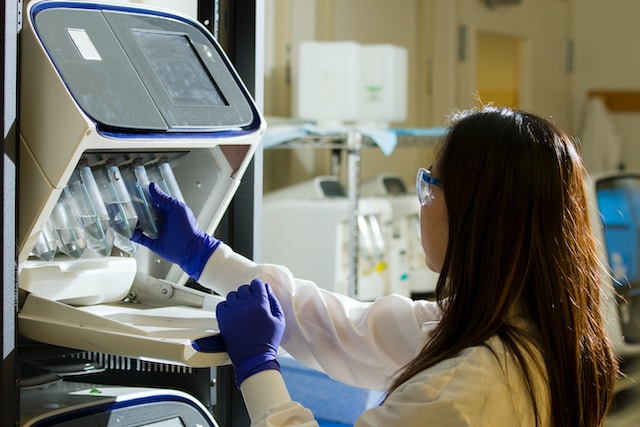Panelists came together in a session titled “Gene Therapy: Let’s Talk about Safety, Baby,” at the 2023 Biotechnology Innovation Organization (BIO) International Convention. Gene therapy is a growing industry aiming to treat or prevent genetic disorders via direct entry of genetic material into an individual’s cells.

To date, there are more than 2,000 therapies under development. While the benefit to directly target the cause of a disease outweighs the alternative option of managing symptoms, the industry understandably faces an equally large discussion of safety.
The session was moderated by Rowan Walrath, Life Sciences Reporter for the Boston Business Journal.
Respective approaches to gene therapy
Ring Therapeutics, PepGen, and Xalud Therapeutics

Scientists at Ring Therapeutics have uncovered and are utilizing commensal anelloviruses to target a wide array of diseases. Per Tuyen Ong, M.D., MBA, CEO-Partner and CEO of Ring Therapeutics at Flagship Pioneering, they use a non-pathogenic delivery approach and a non-integrating virus that inhabits specific tissue without triggering an immune response.
“When considering deployment of the virus, they maintain the versatility to customize the specific modality delivered to the patient. Once within the cell, the viral genome remains a stable single-stranded ring of DNA adjacent to the human genome,” explained Ong. This is intended to be a “programmable platform to incorporate virus-delivered therapeutics with precision and dose adjustability.”
PepGen is focused on developing therapies for rare diseases. As Michelle Mellion, M.D., Senior Vice President, Head of Clinical Development at PepGen, explained, “In regard to the treatment of neuromuscular diseases, PepGen is focused on making a transformative change utilizing their Enhanced Delivery Oligonucleotide (EDO) platform, which has shown to effectively target the root cause of several specific genetic diseases.” The potential of oligonucleotides is well-known as it pertains to muscular diseases such as Duchenne Muscular Dystrophy (DMD) and myotonic dystrophy.
By comparison, Xalud is using a non-viral DNA plasmid vector to restore homeostasis and treat pathologic inflammation within the immune system. Howard Rutman, M.D., MBA, Chief Medical Officer at Xalud Therapeutics, explained, “The focus is on addressing the root cause of inflammation via Interleukin-10 (IL-10). Xalud is looking at more common diseases, such as osteoarthritis of the knee, and utilizing intra-articular injection and direct intrathecal injection of the central nervous system.” According to Rutman, “Unlike with a rare disease population, the advantage of naked DNA allows Xalud to use broader and more chronic indications which allow the vector to be re-dosed.”
Addressing gene-therapy safety
Ong stated that Ring Therapeutics heads off safety concerns by their “ability to precisely deliver anellovirus with the added advantage of dose adjustability.”

At Pepgen, the safety profile of naked oligonucleotide therapy is “well characterized within the patient populations they have chosen,” said Mellion. They have synthesized a short linear positively charged peptide with arginine, and dispersed it via non-natural amino acids. In the center of the arginine is a hydrophobic core that increases the delivery of the oligonucleotides to the tissues of interest. From past experience, they know the potential safety profile of many of the oligonucleotides and their effect on the liver or kidneys, so they are able to safely monitor these organs. Mellion continued, describing that “they take into account what is measurable, monitorable, and reversible to ensure safety in the rare disease population especially when determining dose and evaluating efficacy.”
Rutman added that “plasmid DNA itself has been used within vaccine development and has an acceptable safety profile.” In terms of design of the plasmid, “They are looking to prevent it from integrating, that it has durability, but that the transgene does not remain permanently within the cells.” The transgene product, or IL-10, has been studied extensively for systemic administration and has a uniquely safe profile among the cytokines.
They understand the potential effects of IL-10 based on the experiences of its use within other programs and have put together a variety of safety measures in order to keep track of those. As there is always a concern for the potential of immune responses with any biologic program, with intraarticular injection of plasmid, they do not see production of anti-IL-10 antibodies or sustained systemic IL-10 levels ensuring rapid clearance of the plasmid. “Xalud has been able to treat over 300 patients with single or repeat doses and have not detected anti-IL-10 antibodies,” said Rutman.
Regulators and safety data sharing

The panel members agreed that adverse events should be faced head on with early disclosure and open communication. Rutman added that manufacturing with regulators is vital so that policy standards are met, including relevant expectations for safety and quality.
Mellion described a coordinated effort amongst the companies to learn about potential safety factors at conferences, especially from those that share similar molecules. This includes the risks, benefits, and participant’s side effects within clinical trials. Finally, the opportunity to learn from one another enables protocol modification with synergistic benefits at a later date as gene and oligonucleotide therapies could potentially work together for greater efficacy.
Significant progress has been made addressing safety concerns associated with gene therapy. The utilization of new vectors, innovative delivery techniques, non-viral approaches, and safety data sharing play a role in the efficacy and safety of gene therapy treatments. Ongoing research, rigorous clinical trials, and regulatory oversight are crucial within this rapidly evolving paradigm.




